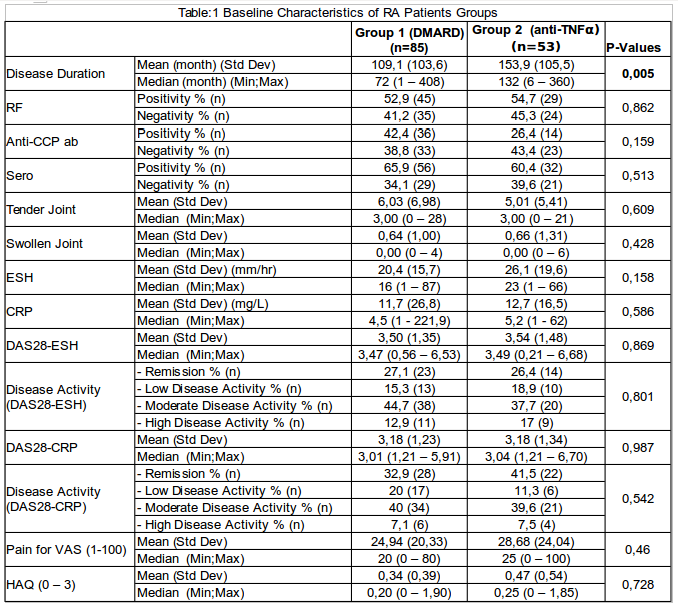Session Information
Date: Sunday, November 8, 2015
Title: Rheumatoid Arthritis - Human Etiology and Pathogenesis Poster I
Session Type: ACR Poster Session A
Session Time: 9:00AM-11:00AM
Background/Purpose: Rheumatoid arthritis (RA) is an inflammatory disease that leads to bone erosion. Bone morphogenetic proteins (BMPs) have favourable effects in the recovery of bone damage by stimulating the differentiation of osteoblasts. The effect of BMPs and their inhibitors in the mechanism of bone destruction has not been identified yet. The plasma levels of BMP 2, 3, 4, 5, 6, 7, 9, 14, noggin, sclerostin in RA patients and healthy volunteers were compared and correlated with the disease activity, clinical and radiographic progression.
Methods: In this prospective cohort study, 138 RA patients fulfilling the 1987 ACR criteria and 80 healthy volunteers aged 18-65 years were recruited. Group 1 consists of 85 patients using non-biologic disease-modifying antirheumatic drugs (DMARD) and group 2 consists of 53 patients using anti-TNFa. Control group was identified as Group 3. All groups were matched on age and sex. Tender/swollen joint, erythrocyte sedimentation rate (ESR), c-reactive protein (CRP), DAS28-ESR, DAS28-CRP, pain and health assessment questionnaire (HAQ) were evaluated clinically. Structural damage was measured by using van der Heijde modified total Sharp scoring method (mTSS). Blood samples were collected. The plasma levels of BMPs, noggin and sclerostin were measured by ELISA method. In all groups, the plasma levels of BMPs and their inhibitors were analyzed by Kruskal-Wallis one-way analysis of variance. Differences between group 1 and group 2 were compared by chi square test and Mann-Whitney U test. P value of 0.05 was considered statistically significant.
Results: Baseline characteristics of group 1 and 2 were shown in table 1 and the comparison of the plasma levels of BMPs in all groups was shown in table 2. The correlation between HAQ and BMP 2, 5,7,14, sclerostin (r=-0,290 p=0,008, r=-0,219 p=0,046, r=0,229 p=0,037, r=-0,273 p=0,013, r=-0,388 p<0.001); between DAS28-ESR and BMP 2, 5,14, sclerostin (r=-0,236 p=0,03, r=-0,259 p=0,017, r=-0,216 p=0,047, r=-0,358 p=0,001); between DAS28-CRP and BMP 2, 5, sclerostin (r=-0,257 p=0,018, r=-0,236 p=0,03, r=-0,330 p=0,002) were statistically significant in DMARD group. There was no correlation in anti-TNF group.
Conclusion: The plasma levels of BMP 2, 4, 5, 6, 7, 9, 14 are increased, whereas BMP subgroup inhibitors which are BMP 3, noggin and sclerostin are decreased and the differences between the results of RA patients using anti-TNFa and healthy volunteers were statistically significant. In this 1-year follow-up study, the plasma levels of BMPs and their inhibitors, HAQ, mTSS and clinical evaluation will be repeated one year later.
To cite this abstract in AMA style:
Kockara O, Ataman S, Gungoren MS, Akbiyik F, Karabulut E. Plasma Levels of Bone Morphogenetic Protein (BMP) Subgroups and Their Inhibitors (noggin, sclerostin) in Rheumatoid Arthritis Patients and Correlation with Disease Activity, Clinical and Radiographic Progression: Preliminary Results [abstract]. Arthritis Rheumatol. 2015; 67 (suppl 10). https://acrabstracts.org/abstract/plasma-levels-of-bone-morphogenetic-protein-bmp-subgroups-and-their-inhibitors-noggin-sclerostin-in-rheumatoid-arthritis-patients-and-correlation-with-disease-activity-clinical-and-radiographic/. Accessed .« Back to 2015 ACR/ARHP Annual Meeting
ACR Meeting Abstracts - https://acrabstracts.org/abstract/plasma-levels-of-bone-morphogenetic-protein-bmp-subgroups-and-their-inhibitors-noggin-sclerostin-in-rheumatoid-arthritis-patients-and-correlation-with-disease-activity-clinical-and-radiographic/


